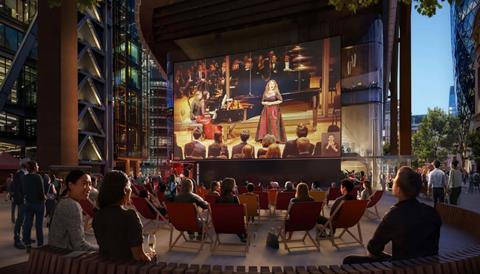Security measures for proposed seven-metre high digital screen would create “environment of surveillance”, pension scheme says
Stanhope has not addressed “fundamental objections” to its 74-storey 1 Undershaft scheme despite sending lead architect Eric Parry back to the drawing board to make a series of design changes, a neighbouring occupier has said.
The Universities Superannuation Scheme (USS), a £90bn pension scheme, has upheld its objection to what would be the joint tallest building in the UK and the tallest in the City of London.

Amended proposals for the office tower are expected to be presented to the City’s planning committee next month, five months after a decision was deferred by councillors amid concerns over a loss of public realm on the site.
In July, councillors told development manager Stanhope and developer Aroland to address the loss of around 30% of St Helen’s Square, one of the largest expanses of open space in the eastern part of the City, before bringing the planning application back for a second hearing.
>> See also: Eric Parry cuts back footprint of 1 Undershaft tower ahead of second planning hearing
Eric Parry’s revised designs, submitted last month, have trimmed the footprint of the tower in order to reduce the loss of public space to around 20% and made a series of revisions to the site’s landscape design including the addition of a seven metre-high digital screen.
But Deloitte, writing on behalf of USS, has said the changes “do not address the fundamental objections” set out in a previous letter of objection sent by the firm in March and has renewed its call for the scheme to be refused.
USS also said it “strongly objects” to the proposed digital screen due to the increased security measures it will require to prevent vandalism and misuse.
“The need for such robust security measures creates an environment of surveillance rather than one of openness and accessibility, ultimately detracting from the desired character of a welcoming and freely accessible public space,” the letter said.
It added that the screen would “contradict the creation of a high quality public realm” which is being sought by City councillors in the revised submission.
“St Helen’s Square should offer respite and a visual contrast to the digital saturation of many workplaces,” USS said. “Introducing a large, dominant screen detracts from the potential for a calm and engaging public space where individuals can enjoy their surroundings.”
Meanwhile, another neighbouring occupier, The Wardens and Society of the Mistery or Art of the Leathersellers of the City of London, has said it has “major concerns” about the potential impact of the proposed tower on its daylight levels.
The Leathersellers’ Company owns 12 properties in the immediate vicinity of the St Helen’s Square site, although in a letter to the application written by Ethersheds Sutherland it said it was yet to conclude a detailed impact assessment of the scheme.
Objections to Eric Parry’s previously submitted plans for the tower included a letter from Lloyd’s chairman Bruce Carnegie Brown, who said it would “rob the City of a really important convening space”.
The letter, which called for the proposals to be refused, was submitted just two days before the application’s planning committee hearing in July with a recommendation for approval from City planning officers.
An assessment of the amended plans by Historic England is expected to be published in the coming weeks. The influential heritage advisor had called for the initial plans to be refused due to the impact on St Helen’s Square and nearby listed heritage assets.
Stanhope and Eric Parry have been contacted for comment.




























No comments yet